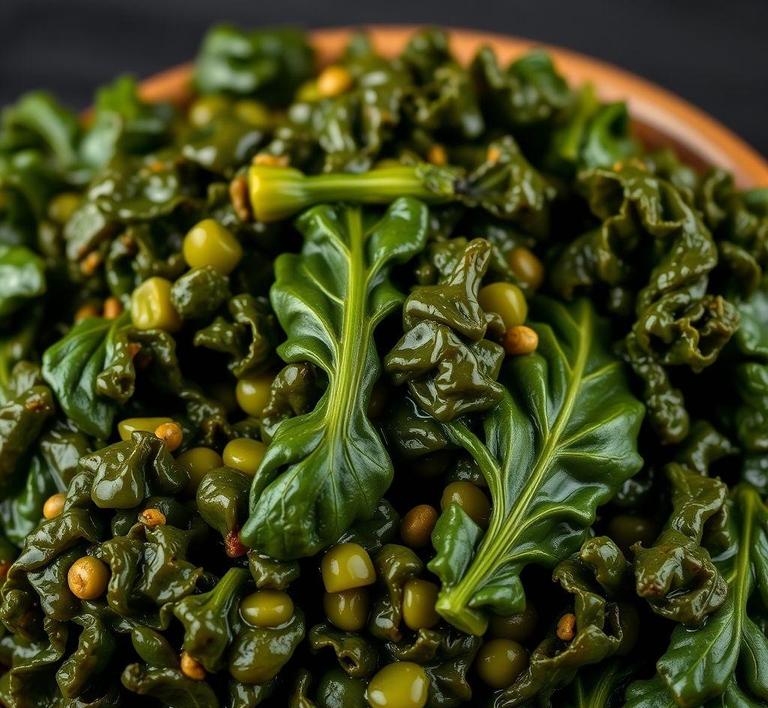Wondering if you can refreeze cooked collard greens? You’re not alone! Collard greens, like many other cooked vegetables, can be a bit tricky when it comes to storing leftovers. Freezing them after they’ve been cooked can help you extend their shelf life, but you need to know the right steps to preserve their flavor and texture. In this guide, we’ll walk you through the best practices for refreezing cooked collard greens so they stay fresh and delicious, even after thawing. Whether you’re making a big batch for later or just trying to avoid food waste, knowing how to refreeze collard greens properly can make all the difference.
Can You Refreeze Cooked Collard Greens?

The question of whether you can refreeze cooked collard greens is one that often arises when meal planning or when you’re left with leftovers. While it’s technically possible to refreeze cooked collard greens, it’s important to understand the nuances of how freezing and refreezing impact the quality and safety of the food.
Collard greens, like many vegetables, have a high water content, and freezing them alters their cell structure. When frozen, ice crystals form inside the plant cells, which can rupture them. This process can lead to a change in texture, color, and flavor. Therefore, refreezing cooked collard greens may intensify these effects. Each time you freeze and thaw food, the texture and taste degrade further, making the greens less desirable when reheated.
From a safety perspective, the key concern with refreezing is the handling of the greens during the thawing and refreezing process. If the cooked collard greens were left out at room temperature for too long during the thawing phase, bacteria may have had a chance to grow, which could lead to foodborne illness upon refreezing. To minimize risk, it’s important to ensure that the greens are kept at a safe temperature throughout the entire process.
In summary, while you can refreeze cooked collard greens, it’s not ideal due to the potential quality deterioration and food safety concerns. But, if you absolutely need to, there are steps you can take to ensure the best outcome.
How To Refreeze Cooked Collard Greens?
If you’ve decided to go ahead with refreezing your cooked collard greens, there are some best practices that can help preserve the quality and safety of the food.
-
Cool the Collard Greens Quickly
One of the most crucial steps in the freezing process is ensuring that the cooked greens cool down as quickly as possible before refreezing. The USDA recommends that cooked foods be cooled to room temperature within two hours to avoid bacterial growth. To speed up the cooling process, you can divide the greens into smaller portions or place the container in an ice water bath, which helps bring the temperature down faster.
-
Store Properly in Airtight Containers or Freezer Bags
For refreezing, it’s essential to store the collard greens in airtight containers or heavy-duty freezer bags. Freezer bags are great for removing excess air, which helps prevent freezer burn. If using containers, make sure they are sealed tightly to prevent any moisture loss or absorption of freezer odors. Additionally, portion out the greens into smaller serving sizes so that you don’t need to thaw and refreeze the entire batch repeatedly.
-
Label and Date
It’s always a good idea to label your containers with the date you’re refreezing the collard greens. This helps keep track of how long they’ve been in the freezer and ensures that they’re used before they lose too much quality. Refrozen collard greens are best used within 1-2 months for optimal taste and texture.
-
Thawing and Reheating
When you’re ready to use your refrozen collard greens, it’s important to thaw them safely. The best way to thaw collard greens is in the refrigerator overnight, as this keeps them at a safe temperature. Avoid thawing them at room temperature, as this can promote bacterial growth. Once thawed, you can reheat them by simmering on the stove or microwaving them, but remember that their texture may not be as tender as freshly cooked greens.
Quality Impact
Refreezing cooked collard greens will inevitably impact their quality in a few key areas. Let’s explore the primary effects on texture, flavor, and appearance:
- Texture: Collard greens have a natural fibrous texture, and freezing breaks down cell walls. Upon refreezing, the greens may become mushier, with a limp or soggy consistency when reheated. This is particularly noticeable in leafy vegetables like collards, which rely on their firm texture for that signature bite. Freezing and refreezing can exacerbate this issue, making them less desirable for dishes where a crispy or al dente texture is essential.
- Flavor: The freezing process can also dull the flavor of collard greens. Refreezing can cause the greens to lose some of their vibrant taste, making them slightly more bland or overcooked when reheated. While the taste may not be drastically different, the intensity of the flavor could diminish, especially if the greens were cooked with spices or seasonings that may lose their potency after multiple freezes and thaws.
- Appearance: As mentioned earlier, the water content in collard greens can cause them to lose their vibrant green color when frozen and refrozen. The leaves may become darker, which can affect the overall presentation. For people who enjoy their food to look as good as it tastes, this color change can be a bit of a dealbreaker, even though it doesn’t necessarily affect the nutritional quality.
In short, while the nutritional content of collard greens remains largely intact through freezing, the texture, flavor, and appearance can suffer, especially if they’ve been frozen and thawed multiple times.
Refreezing cooked collard greens is technically possible, but it is not without its challenges. The quality of the greens will likely decline with each freezing cycle, resulting in a soggier texture, a diminished flavor, and a loss of vibrant color. Additionally, food safety is a concern if the greens are not handled correctly during the thawing and refreezing process. To maintain the best possible quality, it’s recommended to avoid refreezing when possible, and instead, freeze in smaller portions to prevent the need for multiple thawing and refreezing cycles.
However, if you follow the proper cooling, storage, and thawing procedures, you can still enjoy refrozen collard greens, but you should be prepared for a less-than-perfect outcome in terms of taste and texture. In the end, the decision to refreeze cooked collard greens depends on your priorities-whether you’re more concerned with minimizing waste or accepting a slight decrease in quality. Either way, careful handling can ensure that you’re still able to enjoy these nutritious greens even after they’ve been frozen and refrozen.
Is It Safe To Refreeze Cooked Collard Greens?
When it comes to refreezing cooked collard greens, the short answer is: it depends. While it is technically safe to refreeze cooked collard greens under the right conditions, the quality of the dish may be compromised. The process of freezing and thawing can affect both the texture and flavor of the greens. Collard greens are composed primarily of water, and the freezing process causes ice crystals to form in the cellular structure of the plant. When they’re thawed, this water is released, leaving the greens a bit soggy or mushy. This effect is amplified when the greens are frozen and thawed multiple times.
However, if cooked collard greens are handled and stored properly, they can be refrozen without posing a significant health risk. The primary concern when refreezing cooked collard greens is not food safety, but the potential decline in quality. The food safety aspect is mainly dependent on how the greens were thawed and how long they’ve been at room temperature during handling.
To safely refreeze cooked collard greens, it’s important to follow these steps:
- Ensure the greens are completely cooled before freezing to prevent bacteria growth.
- Freeze the greens as soon as possible after cooking to preserve their freshness and flavor.
- Only thaw and refreeze once. Repeated cycles of freezing and thawing increase the risk of foodborne illnesses and cause texture deterioration.
By taking care in handling the greens and following proper food safety protocols, you can minimize the risk of spoilage and the effects of multiple freeze-thaw cycles.
Signs That Cooked Collard Greens Should Not Be Refrozen
While refreezing cooked collard greens is often safe from a health perspective, there are certain signs that indicate the greens should not be refrozen. These signs typically suggest that the quality has already declined, or that the greens may no longer be safe to consume. Here are the main indicators:
- Off Smell: If your cooked collard greens have developed a sour, rancid, or spoiled odor, they should not be refrozen. This is often a sign of bacterial growth or improper handling during the cooling or thawing process.
- Mushy or Slimy Texture: When collard greens are thawed, the ice crystals that formed during freezing can cause the plant cells to break down. If the greens feel excessively slimy or mushy, they are likely past their prime and should not be refrozen.
- Discoloration: If you notice darkening or any off-color spots, this can be a sign of spoilage. The color change can happen if the greens were stored improperly, or if they’ve been sitting out at room temperature for too long.
- Unusual Taste: If the cooked collard greens taste bitter or off in any way after thawing, they should not be refrozen. A significant flavor change indicates spoilage, and the greens should be discarded for safety.
- Long Exposure to Warm Temperatures: If the cooked collard greens were left out at room temperature for longer than two hours (or one hour if the room is very warm), bacteria could have started to grow. Even if the greens were refrozen afterward, there’s a risk of foodborne illness.
In all of these cases, it’s safer to dispose of the greens rather than risk health complications. Better to be cautious than to consume food that may have gone bad.
Common Refreezing Mistakes
Refreezing cooked collard greens can be tricky, and several common mistakes can result in a significant drop in quality or even potential safety hazards. Below are some of the mistakes to avoid when refreezing collard greens:
- Thawing Too Slowly: Many people make the mistake of letting their collard greens thaw on the counter at room temperature. This allows the greens to stay in the “danger zone” (40°F – 140°F) for too long, which can lead to bacterial growth. Always thaw in the refrigerator for the safest results.
- Not Cooling Properly Before Freezing: If you freeze cooked collard greens while they’re still warm, you run the risk of allowing bacteria to multiply. Properly cooling your greens (by placing them in shallow containers and refrigerating promptly) before freezing is crucial to avoid contamination.
- Using the Wrong Storage Containers: Another common mistake is storing the greens in improper containers. For best results, use airtight, freezer-safe containers or freezer bags to prevent freezer burn. Collard greens can lose moisture and flavor if exposed to air during the freezing process.
- Freezing and Thawing Multiple Times: As mentioned, refreezing greens more than once can cause them to deteriorate in texture and flavor. Each freeze-thaw cycle results in a loss of nutrients and water retention in the greens, which will make them limp and mushy. Only thaw what you intend to use immediately.
- Overloading the Freezer: Freezing large quantities of cooked collard greens at once can overwhelm your freezer. It’s important to freeze greens in smaller portions so they freeze quickly and evenly. Overcrowding the freezer can also affect airflow, leading to uneven freezing.
Avoiding these common mistakes will help maintain both the safety and the quality of your cooked collard greens, allowing you to enjoy them even after freezing.
Tips And Tricks
To maximize the taste and texture of refrozen collard greens, consider the following tips:
- Portion Control: Freeze your collard greens in smaller portions rather than one large batch. This way, you can take out only what you need without having to refreeze the entire batch. This also prevents waste and ensures better texture upon reheating.
- Blanching Before Freezing: If you’re planning to freeze collard greens after cooking, consider blanching them first. Blanching involves briefly boiling the greens and then plunging them into ice water to halt the cooking process. This helps preserve the color, flavor, and nutrients of the greens before freezing.
- Use Freezer Bags for Space-Saving: If you’re short on storage space, freezer bags are an excellent option for storing collard greens. Squeeze out as much air as possible before sealing to reduce the risk of freezer burn. Lay the bags flat in the freezer for better organization and quicker freezing.
- Label and Date: Always label your frozen greens with the date they were cooked and frozen. Collard greens can be stored in the freezer for up to 12 months, but you should consume them within 3-6 months for the best flavor and texture. Knowing when you froze them ensures you don’t keep them for too long.
- Reheating Properly: When reheating frozen collard greens, do so slowly to preserve the texture. It’s best to thaw the greens in the refrigerator overnight and then reheat them on the stovetop or in the microwave. Adding a bit of broth or water can help prevent them from becoming too dry or tough.
Conclusion
Refreezing cooked collard greens is safe in terms of food safety if done correctly, but the quality of the greens will inevitably decline with each freeze-thaw cycle. The biggest concern when refreezing is not typically health-related but the loss of texture, flavor, and nutrients that occurs when collard greens are repeatedly frozen. By carefully following food safety guidelines, avoiding common mistakes, and using proper storage methods, you can minimize the negative effects of refreezing. It’s best to freeze collard greens only once and to store them in smaller portions to avoid wasting them. If you handle your greens with care, you can enjoy this nutritious and flavorful vegetable long after the initial cooking.
Ultimately, while you can refreeze cooked collard greens, you should always assess their quality before doing so and avoid any signs of spoilage. With the right practices in place, you can ensure your collard greens stay as fresh and delicious as possible for future meals.


